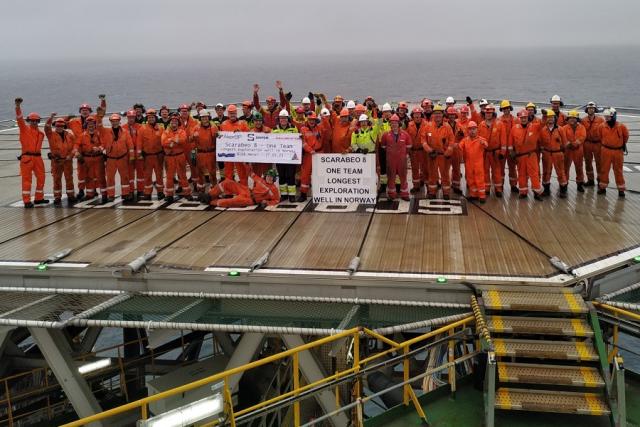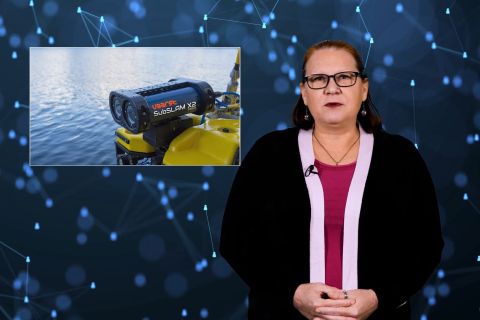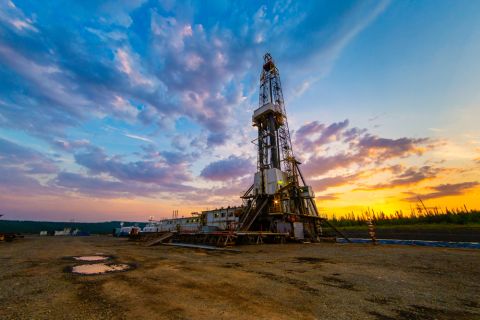
The team behind Aker BP’s record-breaking horizontal well offshore Norway. (Source: Aker BP)
Aker BP’s Øst Frigg Beta/Epsilon well on the Norwegian Continental Shelf is not just a regional record-breaker, it has increased the estimate of resources in the Yggdrasil area.
In May, Aker BP reported the find, although drilling was still in progress, with pre-drill estimates ranging from 18 MMboe to 45 MMboe. On June 9, Aker BP updated its late May estimate from between 40 MMboe and 90 MMboe to 53 MMboe to 90 MMboe. The operator said this discovery increases the resource base at Yggdrasil by about 10% to more than 700 MMbbl. The Storting, Norway’s parliament, recently approved the Yggdrasil development, which is expected to go onstream in 2027.
Øst Frigg was originally a gas discovery from the Alpha and Beta structures from the 1970s, although 10 m of oil was found under the gas. Elf produced the gas in the 1980s and 1990s but left the oil untouched.
“This means that we’ve got more than 250 million barrels of proven oil, yet to be produced, in the middle of an area we’re going to develop. We had to get to the bottom of this,” Aker BP subsurface manager Tor-Ole Jøssund said in a press release.
Aker BP started its hunt for the Øst Frigg oil in early 2022, starting with a sidetrack to Øst Frigg Alpha drilled from the Grefsenkollen well. While there were oil shows, it was “too spread out to recover. This wasn’t the result we were hoping for,” Jøssund said.
The subsurface team worked out a plan to drill horizontally in Beta and Epsilon.
The Scarabeo 8, Saipem’s 6th-generation harsh environment drilling semisubmersible, started the drilling campaign in April in 110 m water depth.
The Øst-Frigg Beta/Epsilon wildcat well has a vertical main track and three horizontal sidetracks. The first sidetracks were drilled in the Beta structure to prove oil and appraise the discovery. The sidetrack to Epsilon was the last one and most of the Beta well was used to reach the Epsilon structure. The last casing was landed in the reservoir and drilling of the horizontal section towards Epsilon started. The results were promising, and the drilling continued toward the Gamma structure. Over a period of two weeks, the team drilled more than 6,000 m, open hole and horizontally, in the reservoir to collect geological data, with all operations monitored from Aker BP’s drilling operations center in Trondheim.
Aker BP drilling superintendent Hanna Tronstad called drilling 6 km horizontally “a significant achievement. It requires precision and the ability to constantly assess risk against reward based on a continuous stream of data, as exploration wells have higher uncertainty than regular wells. We’re also doing this with a rig that’s new to Aker BP.”
Target depth of the well was 8,168 m.
Tronstad said the Øst Frigg Beta/Epsilon well proved that Aker BP could drill horizontally–and over long distances–in the Frigg formation.
“Aker BP is planning 55 wells in the Yggdrasil area. Drilling is scheduled to start in 2025, and we’ll be spending the years leading up to this ensuring efficient planning and implementation of the production wells, many of which are horizontal,” Tronstad said.
The Øst Frigg Beta/Epsilon discovery is in PL873 and PL442. Aker BP operates PL 873 with 47.7% interest on behalf of partners Equinor with 40% and PGNiG Upstream Norway with 12.3%. Aker BP operates PL 442 with 87.7% interest on behalf of PGNiG with 12.3% interest.
Recommended Reading
TGS, SLB to Conduct Engagement Phase 5 in GoM
2024-02-05 - TGS and SLB’s seventh program within the joint venture involves the acquisition of 157 Outer Continental Shelf blocks.
2023-2025 Subsea Tieback Round-Up
2024-02-06 - Here's a look at subsea tieback projects across the globe. The first in a two-part series, this report highlights some of the subsea tiebacks scheduled to be online by 2025.
StimStixx, Hunting Titan Partner on Well Perforation, Acidizing
2024-02-07 - The strategic partnership between StimStixx Technologies and Hunting Titan will increase well treatments and reduce costs, the companies said.
Tech Trends: Autonomous Drone Aims to Disrupt Subsea Inspection
2024-01-30 - The partners in the project are working to usher in a new era of inspection efficiencies.
Drilling Tech Rides a Wave
2024-01-30 - Can new designs, automation and aerospace inspiration boost drilling results?





